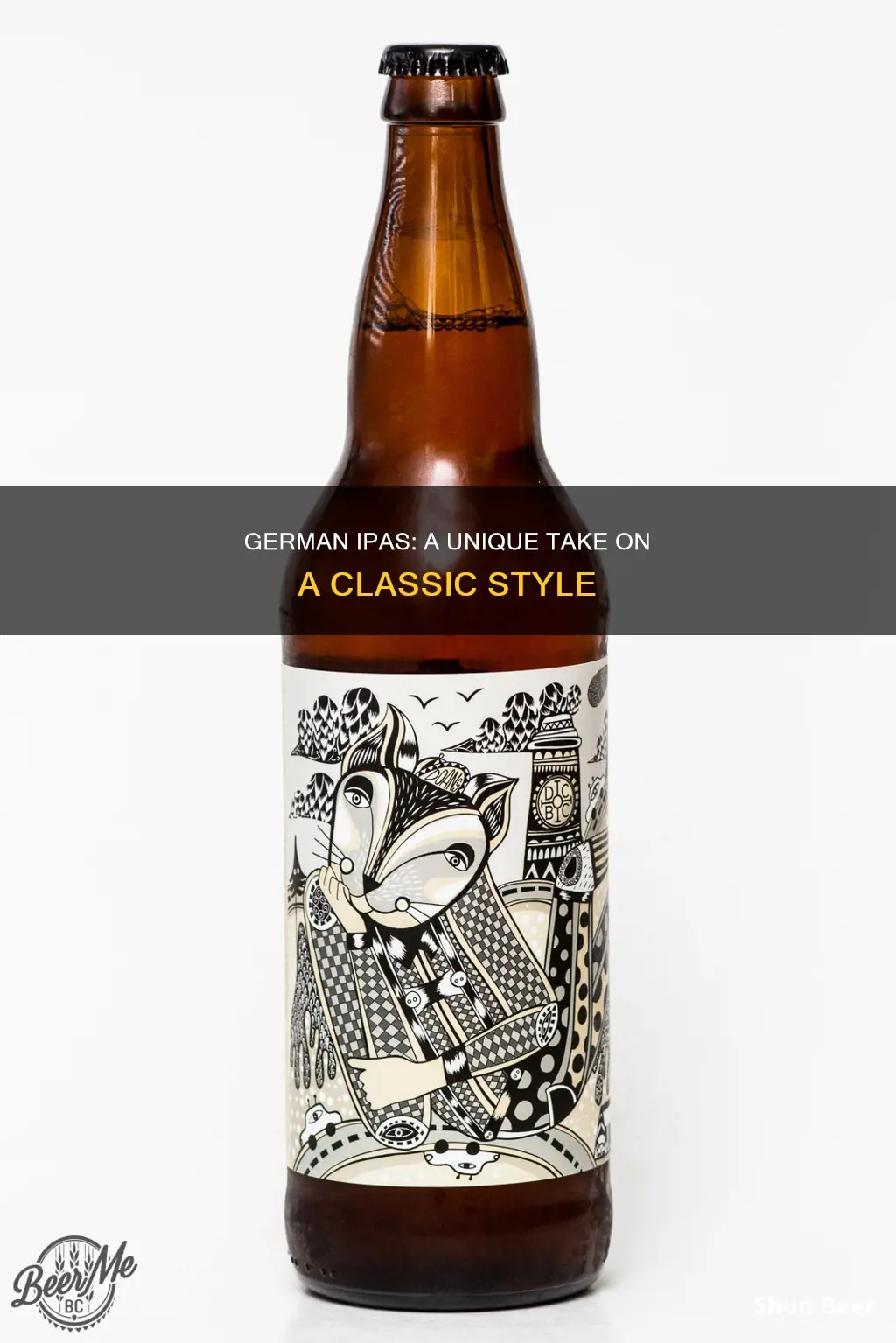
India Pale Ale (IPA) is not a typical German beer. However, some German breweries do produce IPAs, and the style is growing in popularity in the country. German IPAs tend to be modelled on American IPAs, embracing New World hops. Nevertheless, some brewers are creating IPAs with German ingredients, particularly the country's distinctive aroma hops.
| Characteristics | Values |
|---|---|
| Country | Germany |
| Beer type | IPA |
| Availability | Rare |
| Ingredients | German hops, Amarillo, Cascade, Centennial, Citra, Comet, Falconer's Flight, Idaho 7, Mandarina Bavaria, Magnum, Polaris, Simcoe, Vic Secret |
| ABV | 6.5% |
| IBUs | 40-60 |
| Colour | Golden |
| Body | Light |
What You'll Learn

German IPAs are rare but they do exist
Germany is a seminal region for beer, but it is not known for its IPAs. In fact, one beer enthusiast who has been drinking and writing about beer and brewing for 15 years says that the absence of a German IPA is striking.
However, IPAs do exist in Germany, and there are internationally oriented breweries that specialise in them. While it is more difficult to find one that embraces German ingredients, particularly the country's distinctive aroma hops, they do exist. For example, Paul Higgins, an American brewer in Munich and cofounder of Higgins Ale Works, uses German aroma hops and New World varieties in his IPAs. His Retro-Rocker Red IPA features German-grown Amarillo, Comet, and Polaris hops alongside US varieties.
Another IPA brewer in Germany is Eric Toft, the Wyoming-born brewmaster at Private Landbrauerei Schönram in Upper Bavaria, who says:
> "We use only German varieties. Since everyone is using US hops now, it is not so much fun to use them. And German hops give a similar profile, but with a definite continental European terroir character."
In addition to these breweries, there are a few others that produce German IPAs, including Camba, Crew Republic, and Ratsherren.
Guinness Beer: A Domestic or Foreign Affair?
You may want to see also

German brewers have mostly modelled their IPAs on American ones
One example of a German brewery that unabashedly embraces this American influence is BRLO in Berlin. Their IPA is brewed with only pilsner malt and dry-hopped with Mosaic, Amarillo, and Citra hops—a style that's "as 'West Coast' as it gets," according to BRLO's brewmaster, Michael Lembke.
However, it's worth noting that while many German brewers started with American hops in American-style IPAs, a few others have gone in a more local direction, using German hops and ingredients to create a unique take on the IPA style.
For instance, Paul Higgins, an American brewer in Munich and co-founder of Higgins Ale Works, embraces both German aroma hops and New World varieties in his pale ales and IPAs. He believes that "IPAs can generally take on new twists with local ingredients or techniques that otherwise were not attempted."
Another example is Eric Toft, the brewmaster at Private Landbrauerei Schönram in Upper Bavaria, who uses only German hop varieties. Toft explains that German hops give a similar profile to American hops but with a definite continental European terroir character.
While German IPAs may not be as common or well-known as their American counterparts, it's clear that the style is gaining traction in Germany, with brewers experimenting with both American and local ingredients to create unique and delicious IPAs.
Guinness Beer: A Union Brew?
You may want to see also

German craft beer is 20 years behind
German craft beer is said to be 20 years behind, with a lot of the "crappy places" yet to be shaken out. However, Germany has a rich history of brewing and is a seminal region for beer, so it is not accurate to say that craft beer is 20 years behind in Germany.
Germany has a long tradition of brewing, with over 1,300 breweries producing some 5,500 different types of beer. German beer is a major part of German culture, and the country is serious about its "bier". In fact, there is a German word, "bierernst", which means "deadly serious" and translates literally as "beer serious".
For centuries, German law has stipulated that beer can only be made from four ingredients: water, hops, barley, and yeast. This is known as the German Beer Purity Law, or the Reinheitsgebot, which was introduced in 1516 by Duke Wilhelm IV of Bavaria. While some believe this law impedes good brewing, it has served Bavaria and the rest of Germany well for centuries.
However, tastes are changing, and some Germans feel that German beer is not as good as it used to be. There is a growing interest in craft beer in Germany, and some breweries are experimenting with new ingredients and techniques. This shift is partly influenced by the vibrant US beer scene, with German brewers modelling their IPAs on American ones and embracing New World hops.
While German craft beer may be considered behind in terms of innovation and variety when compared to the US, it is important to note that beer in Germany is more of a staple than an adventure. German IPAs tend to be more tame and drinkable, with a focus on local ingredients and techniques. Additionally, the perceived demand of German drinkers needs to be considered, with a preference for lower alcohol content and less intense bitterness.
Despite the traditional focus, there are German breweries that are embracing the craft beer movement and creating unique and innovative beers. For example, Berliner Berg, one of Germany's newest breweries, is pushing the boundaries of the German beer palate by adding ingredients such as orange peel or coriander. Additionally, breweries like Crew Republic in Bavaria and Camba are known for their excellent IPAs.
In conclusion, while German craft beer may be considered behind in comparison to other countries, it is evolving and there are breweries that are creating exciting and innovative beers. The rich history of brewing in Germany, combined with a growing interest in craft beer, is leading to new and unique offerings that showcase local ingredients and techniques.
Guinness Beer: A Low-FODMAP Diet-Friendly Drink?
You may want to see also

German beers are more of a staple than an experience
German beers are steeped in tradition and history. The country's beer market is weaker but more centralized in the north, while the south has many smaller, local breweries. In fact, almost half of all German breweries are in Bavaria, where the seven main breweries produce 158 million US gallons annually.
The highest density of breweries in the world is found in Aufseß, near the city of Bamberg, in the Franconia region of Bavaria, with four breweries and only 1,352 citizens. The Benedictine abbey Weihenstephan brewery, established in 725, is reputedly the oldest existing brewery in the world and has been brewing since 1040.
German beers are also subject to the Reinheitsgebot (Purity Law), which was established in 1516 and stipulates that only four ingredients are permitted for brewing beer: water, barley, hops, and yeast. This law still stands today and sets German beers apart from those in other countries.
When it comes to styles, German beers offer a diverse range. From pilsners and lagers to wheat beers and dark ales, there is something for everyone. Regional specialties also abound, such as Altbier from Düsseldorf, Kölsch from Cologne, and Weizenbier or Weißbier (wheat beer) from Bavaria.
While German beers may not be as adventurous as their North American counterparts, they make up for it with their rich history, traditional brewing techniques, and unwavering commitment to quality. German beers are a staple in the country's culture and are best enjoyed in the convivial atmosphere of a bierkeller or biergarten, where people of all ages come together to share a drink and a good time.
Guinness Beer and Coffee: What's the Connection?
You may want to see also

German beer culture is quite boring
The German "Beer Purity Law", or "Reinheitsgebot", dates back to 1516 and states that beer can only be made with water, hops, yeast, and malt. While this law has ensured the quality of German beer, it has also limited innovation and exploration of different styles.
In recent years, there has been a rise in craft breweries and more diverse beer styles in Germany, but it is still relatively niche and mostly found in bigger cities. The German craft beer scene emerged around 2010, and many brewers were inspired by the vibrant US beer culture, particularly the popularity of IPAs. However, German IPAs are rare, and brewers have mostly modelled their IPAs on American ones, using New World hops.
Despite the lack of variety in traditional German beer styles, the country has a rich beer history and a strong drinking culture. Beer is an essential part of German social life, and the country is home to the world's largest beer festival, Oktoberfest, which attracts over 6 million visitors each year.
While German beer culture may be considered boring by those seeking more diverse styles, it is deeply rooted in tradition and plays a crucial role in the country's social and cultural life.
Microbreweries and IPAs: A Perfect Match?
You may want to see also
Frequently asked questions
Yes, but they are rare. German brewers have mostly modelled their IPAs on American ones, but there are a few breweries that have gone in a more local direction.
Some German IPAs include Drunken Sailor by Crew Republic, West Coast IPA by Ratsherren, and beers from the breweries Fraugruber and Fuerst Wiacek.
German beers that IPA lovers might enjoy include pilsners, helles, doppelbock, and wheat beers such as hefeweizen and weizenbock.
Some popular German beers include Export, Helles, Maibock, Märzen, Pilsener, Spezial, Bock, Doppelbock, Dunkel, Schwarzbier, Weizenbier, and Weißbier.







